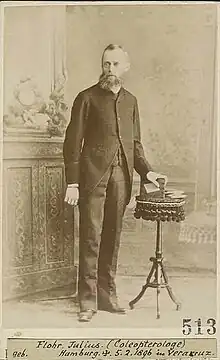Julius Flohr
Julius Flohr (11 February 1837 – 8 February 1896) was a German banker and entomologist resident in Mexico.[1]

Early life
Flohr was born in Hamburg, in what was then the German Confederation, on 11 February 1837.[2] He was educated there and in England.[3]
Banking career
In 1859, Flohr moved to Mexico City to work as a banker.[3] In 1862, he joined Esteban Benecke & Co., a bank in which he became a life-long partner.[4][3] Benecke was the Prussian consul and one of Mexico's first bankers.[5]
Entomological pursuits
Flohr retired from day-to-day banking in 1877 and devoted himself to the study of insects, especially beetles. Interest in comparative anatomy remained high following the publication of Darwin's On the Origin of Species, and Flohr's field work was cited extensively in the Biologia Centrali-Americana encyclopedia.[3][4]
Between 1878 and 1885, British naturalist Henry Walter Bates named several species of North American beetle for Flohr, including
In 1884, Flohr accompanied American zoologist Edward Drinker Cope in Mexico. Cope wrote:
I am indebted to my excellent friend, Dr. Julius Flohr, of the city of Mexico, for a canoe excursion on the lake Xochimilco [...] Here I had an opportunity of seeing the botany and zoology of the very irregular shores, which are so curiously constructed by the art of the natives [...] The ends and shores of the piers are the resting place of innumerable snakes, which can be readily observed from a canoe. The wife of our Indian boatman was particularly acute in detecting these animals before either my friend or myself could see them.[9]
Death
Flohr died in Veracruz on 8 February 1896.[3][lower-alpha 1] He was eulogized by entomologists George Charles Champion in England and Ernst Gustav Kraatz in Germany. Flohr's collection of insect specimens was bequeathed to the Berlin Zoological Museum.[4]
Notes
- The Deutsche Entomologische Zeitschrift records his date of death as 18 February 1896.[4]
References
- Gordh, Gordon (2011). A dictionary of entomology. Internet Archive. Wallingford, Oxfordshire, UK; Cambridge, MA: CABI. p. 581. ISBN 978-1-84593-542-9.
- Weidner, H. (1967). "Flohr, Julius". Biographies of the Entomologists of the World. Geschichte der Entomologie in Hamburg. Abhandlungen und Verhandlungen des Naturwissenschaftlichen Vereins in Hamburg, N. F. p. 116.
- The Entomologist's Monthly Magazine. Entomologist's Monthly Magazine Limited. 1896. p. 91.
- Kraatz, Ernst Gustav (1896). "Julius Flohr" (PDF). Deutsche Entomologische Zeitschrift (in German) (II): 367.
- Ludlow, Leonor (May 1996). [chrome-extension://bdfcnmeidppjeaggnmidamkiddifkdib/viewer.html?file=https://www.revistadelauniversidad.mx/download/06cc0e6f-0bf3-476d-9cd4-036b6cb67781?filename=la-primera-generacion-de-banqueros-en-la-ciudad-de-mexico "La primera generación de banqueros en la Ciudad de México"]. Revista de la Universidad de Mexico (544): 18.
{{cite journal}}: Check|url=value (help) - "Bembidion flohri Bates, 1878". www.gbif.org. Retrieved 2023-10-08.
- "Cerambycidae (Longhorns)". titan.gbif.fr. Retrieved 2023-10-08.
- "Hybothecus flohri (Bates, 1882)". www.gbif.org. Retrieved 2023-10-08.
- Cope, E. D. (1885). "A Contribution to the Herpetology of Mexico". Proceedings of the American Philosophical Society. 22 (120): 386. ISSN 0003-049X.